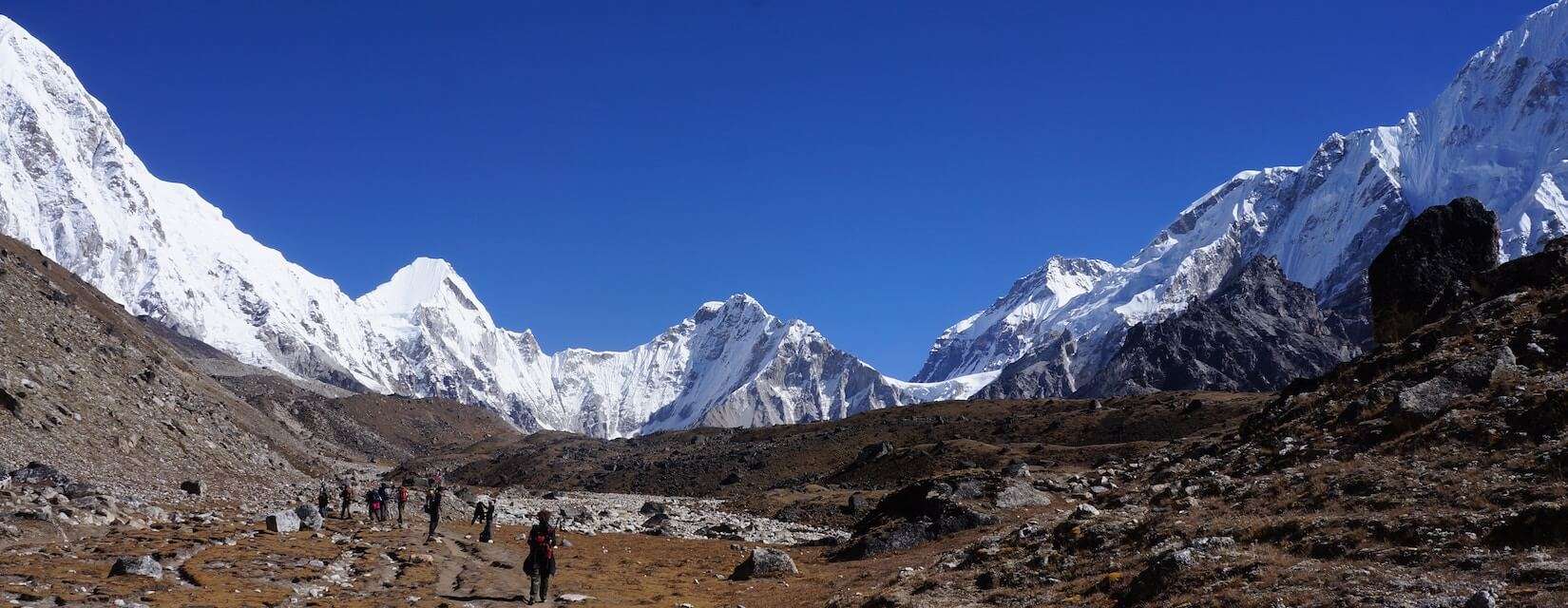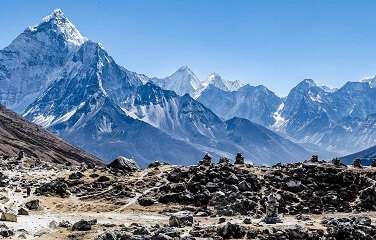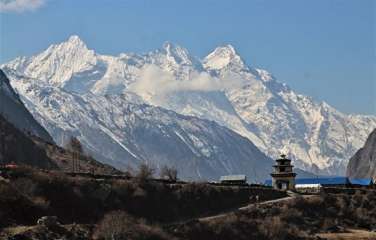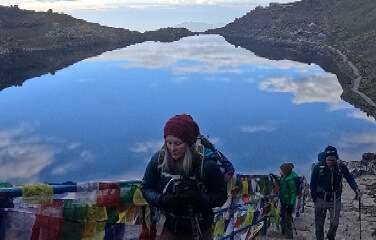Everest Base Camp Trek Comfortable Itinerary

Day 1: Arrival Day
Day 2: Flight From Kathmandu To Lukla And Hike Toward Phakding
Day 3: Phakding To Namche Bazaar
Day 4: Namche Bazaar, Acclimatization Day
Day 5: Namche Bazaar To Tengboche
Day 6: Tengboche To Dingboche
Day 7: Dingboche, Acclimatisation Day
Day 8: Dingboche To Lobuche
Day 9: Lobuche To Gorakshep & Everest Base Camp, E.B.C To Gorakshep
Day 10: Gorakshep To Kalapathar & Back To Pheriche Via E.B.C
Day 11: Pheriche To Namche Bazaar
Day 12: Namche Bazaar To Lukla
Day 13: Morning Flight Lukla To Kathmandu
Day 14: Departure Day
Book Everest Base Camp Trek here.
Hike slow but steady
Starting at 2880 meters at Lukla, the hike to Everest base camp begins. In the US and Europe, this is already larger than a mountain. Therefore, starting on day one, the best tip for a successful climb to Everest base camp is to move slowly but steadily. You will often hike for 6 to 8 hours each day. These strolling hours include stops for pictures and quick tea breaks. You will therefore hike 8 to 12 kilometers per day, depending on the distance. So, slow walking won't be an issue.
However, staying put for an extended amount of time will not keep up the pace. You will arrive at the desired location on foot and in good time. Breathe normally, but keep moving forward. It is best to maintain a steady speed during the entire journey to Everest Base Camp, especially during the ascent. But keep moving and avoid taking extended stops. Take a moment to look back during the break or to collect your breath. You can see how far you've come by looking back, which will make you feel more motivated. Or, occasionally, you'll notice someone approaching you while climbing a hill, which can cheer you up.
Best season to go EBC

Fall (September to November) and spring (March to May), which is also the busiest climbing season for Mount Everest, are the most popular times to trek to EBC. In Nepal, the summer months are rainy season, therefore it's definitely best to avoid trekking during this period (unless you don't mind trekking through the rain with obstructed vistas).
Use a professional trekking agency
You should always look for a reputable trekking organization while organizing your journey, this is our expert advice. Check first to see if the trekking company has a government of Nepal registration.
Make sure it has a functioning website, social media handles, etc. Second. Third, you can also check the firm website for reviews that previous clients have left. Stay away from scams. We advise using an agency if you still have access to an independent guide. They have greater connections with everything, including airlines and hotels. It will therefore be useful in an emergency.
Training for Everest Base Camp Trek

Many people choose not to train before beginning their Everest Base Camp Trek, although it is highly recommended that you engage in some aerobic activity prior to your journey, such as cycling and running. You can prepare for the journey by training on a treadmill, going for a hike on the weekend, taking the stairs rather than the elevator, and going shopping on foot rather than in the car. You can even swim to be ready for this famous climb.
Prepare for flight cancellation
The weather must be good enough for the small aircraft, primarily twin-utters, and Dorniers, to reach Lukla. When you make travel arrangements, you have already agreed to entrust the weather and the pilots' competence with your life. If the weather is poor, flights may be canceled, leaving you with the option of waiting and trying again the following day, taking a really rough road in a jeep to the closest location and walking for an additional few days, paying more to take a sharing helicopter, or even changing your travel plans to go somewhere else, essentially to Annapurna Base Camp. Prepare for any of the situations mentioned above, and if the weather is terrible when you arrive back at your destination, consider waiting until the next day to try flying out.
Everest Base Camp Kit Advice

The only thing that will be able to help you in the event of a medical condition or injury is medication. There are no medical facilities in this high-altitude area, so don't expect any. The only means of injury prevention or injury treatment is medication. Bring a bag with all potential medications and a first aid kit. If you are traveling with a trekking company, they will have all the necessary medication, but you should still bring your own first aid supplies and medications. For recommendations on what supplies to bring for a beginner's Everest Base Camp trip, consult the doctors.
Don't make your bag pack heavy
This is another piece of advice applicable to both the Everest Base Camp Trek and other treks. Just bring what you need. Don't pack too much weight because the bag pack's weight affects how comfortable you are when trekking. Keep unnecessary loads of clothing and beauty items off your person. Make a list, conduct some research on gear if you are unsure of what to bring, and pack accordingly. Given that trekking in Nepal is not for the affluent, you must act and prepare appropriately for the trek.
What will the weather be like?
A number of factors, including the time of year you walk, and the weather in Everest Base Camp might change significantly. The days are often sunny and between 15°C and 22°C from March through May. While temperatures might range from 10°C to 15°C from October to December, days can be shorter and sunnier throughout this time. The temperature can drop significantly and possibly dip below zero at higher altitudes. During the walk, many people typically pack thermals, down jackets, and warm hats.
What equipment do I need?
The time of year and duration of the trips you are taking will influence this. A sleeping bag, a sleeping pad, rain gear, excellent hiking boots, and warm clothing are generally required. You will also need things like gloves, caps, and thermal layers if you are walking in the winter. A daypack, a water bottle, and some basic medical items like paracetamol, antiseptics, antifungal cream, and bug bite cream are also advised to be carried. Read the trek's packing list as well.
How Much Does The EBC Trek Cost?

The typical traveler will spend between $1400 and $2500. Trekking organizations offer unique, somewhat less expensive packages if you are traveling in a group. Your lodging, food, transportation, and guidelines are all included in this price. The price of a porter differs from company to business because some trekking firms include the cost of a porter as part of the package, while others do not. So you might have to pay more if you require a porter. You won't need to spend extra money on getting permissions since the charges are already included in the costs. Numerous other items, like as clothing, trekking equipment, and other necessities, are not included in the price. To see if you have the required supplies, consult the Everest Base Camp Trek Packing List. If not, you can purchase them in Lukla or even Kathmandu. If you haven't already, it would be preferable to purchase such goods in Kathmandu as opposed to Lukla because Kathmandu is more expensive.
What About Solo Trekking? Can I do the Everest Base Camp Trek Alone?
Yes, you can trek alone if you mean alone with a guide. But if you plan to travel the whole way by yourself, I strongly suggest against it. This can be an alternative for experienced hikers who are willing to go off with nothing but a map and some cash in their pockets, but not for novices. You may struggle to discover a suitable road or obtain the necessary licenses without even a guide. Additionally, getting lodging during a busy season will be your largest challenge if you don't have a guide. In addition, going it alone would be disastrous if you sustained an injury or encountered a challenge. There will be people along the way, but you can always count on the locals or other hikers to look out for you. For this reason, it is strongly advised to hike with a guide or a friend.
How Safe Is The Everest Base Camp Trek Route?
Both the locals and the entire area are really nice and safe. Therefore, you don't need to worry about your safety. The locals, known as Sherpas, are very friendly and welcoming. If you'd like, you can even choose to forgo staying in motels and stay in a local's home alternatively.
Be prepared for a flight diversion to Ramechhap in the main seasons
For flights to Lukla, Ramechhap Airport can be thought of as an alternative to Tribhuvan International Airport. It takes 4-5 hours to drive there from Kathmandu. There will be a lot of trekkers flying from Kathmandu to Lukla during Nepal's peak trekking season, which would increase aviation traffic. The Nepal Airport Board periodically changes the Ramechhap to Kathmandu flight's destination to Lukla in order to vary the flow of traffic. In this situation, leave early in the morning towards Ramechhap, which is 140 kilometers from Kathmandu. You can get on your flight to Lukla after you get to Ramechhap. Unlike the 40-minute flight from Kathmandu, it takes only 12 to 20 minutes to reach Lukla from here. Your tour itinerary remains unchanged despite the change in your flight's route.
Everest region Treks





